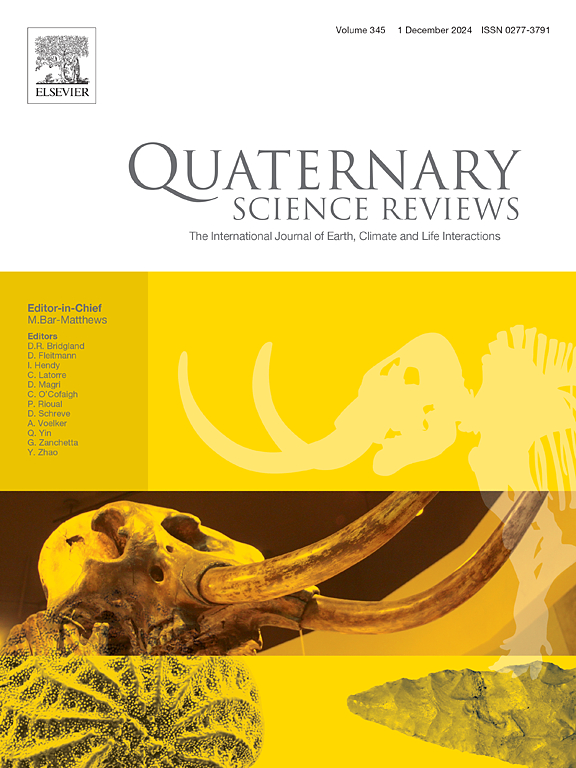New insights into marine-based paleo-ice sheet dynamics and glaciomarine depositional environment in an interfan area between ice stream-derived trough mouth fans, off west Svalbard
IF 3.2
1区 地球科学
Q1 GEOGRAPHY, PHYSICAL
引用次数: 0
Abstract
Understanding the dynamic history of the marine-based paleo-Svalbard Ice Sheet provides critical insights into past climate change and the interactions between the ocean system and the cryosphere. High-resolution seismic imaging is needed to decipher the glacial history of the western Svalbard continental margin, which has experienced multiple glaciations throughout the Quaternary period. Glaciomarine sediments preserved on the continental margin provide a detailed record of these events. We integrate high-resolution airgun seismic (vertical resolution 5 m), and deep-towed transducer seismic data (vertical and horizontal resolutions 1 and 3 m, respectively) along with age constraints derived from a piston core to determine the seismic stratigraphic framework, depositional architecture, and sedimentation processes of the interfan area between the Kongsfjorden and Isfjorden Trough Mouth Fans (TMFs). Age constraints from seafloor drilling indicate that the build-up of the Kongsfjorden TMF began around 1.2 million years ago. Our data analysis reveals four distinct shelf-edge glaciations during the Weichselian period, dated at 120–110 ka, ∼90 ka, 61–54 ka, and ∼24 ka. These glacial units on the upper continental slope contain debris materials transported by slow-moving ice sheets. During maximum glacial expansion, iceberg calving created V-shaped indentations, and glaciogenic debris flows carved erosional troughs. Seismic interpretation and debris flow modeling aided in understanding the development of lensoid debris morphology, stacking patterns, and the evolution of debris lobes resulting from local variations in bottom topography. This study underscores the value of using multiple high-resolution seismic data sources to enhance our understanding of the glacial history and depositional processes in the interfan region.
西斯瓦尔巴群岛冰流衍生槽口扇扇间区域海洋古冰盖动力学和冰海沉积环境的新见解
了解以海洋为基础的古斯瓦尔巴冰原的动态历史有助于深入了解过去的气候变化以及海洋系统与冰冻圈之间的相互作用。斯瓦尔巴特西部大陆边缘在整个第四纪经历了多次冰川期,需要高分辨率地震成像来解读其冰川历史。保存在大陆边缘的冰川沉积物提供了这些事件的详细记录。我们整合了高分辨率气枪地震数据(垂直分辨率为 5 米)、深拖换能器地震数据(垂直和水平分辨率分别为 1 米和 3 米)以及活塞岩芯得出的年龄约束,以确定孔斯峡湾和伊斯峡湾槽口扇(TMFs)之间扇间区域的地震地层框架、沉积结构和沉积过程。海底钻探的年龄限制表明,康斯峡湾 TMF 的形成始于大约 120 万年前。我们的数据分析揭示了魏克瑟尔时期四次截然不同的大陆架边缘冰川,时间分别为 120-110 ka、90 ∼ 90 ka、61-54 ka 和 24 ka。这些位于大陆坡上部的冰川单元包含由缓慢移动的冰原搬运而来的碎屑物质。在冰川最大扩张时期,冰山崩塌造成了 V 形压痕,冰川碎屑流刻画了侵蚀槽。地震解释和碎屑流建模有助于了解透镜状碎屑形态的发展、堆积模式,以及因海底地形局部变化而产生的碎屑裂片的演变。这项研究强调了使用多种高分辨率地震数据源的价值,以加深我们对冰川历史和岩间地区沉积过程的了解。
本文章由计算机程序翻译,如有差异,请以英文原文为准。
求助全文
约1分钟内获得全文
求助全文
来源期刊

Quaternary Science Reviews
地学-地球科学综合
CiteScore
7.50
自引率
15.00%
发文量
388
审稿时长
3 months
期刊介绍:
Quaternary Science Reviews caters for all aspects of Quaternary science, and includes, for example, geology, geomorphology, geography, archaeology, soil science, palaeobotany, palaeontology, palaeoclimatology and the full range of applicable dating methods. The dividing line between what constitutes the review paper and one which contains new original data is not easy to establish, so QSR also publishes papers with new data especially if these perform a review function. All the Quaternary sciences are changing rapidly and subject to re-evaluation as the pace of discovery quickens; thus the diverse but comprehensive role of Quaternary Science Reviews keeps readers abreast of the wider issues relating to new developments in the field.
 求助内容:
求助内容: 应助结果提醒方式:
应助结果提醒方式:


